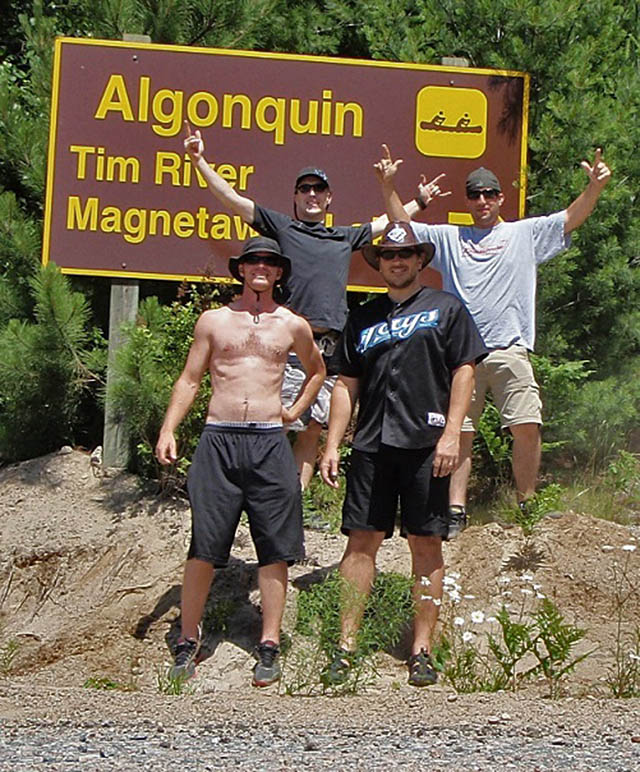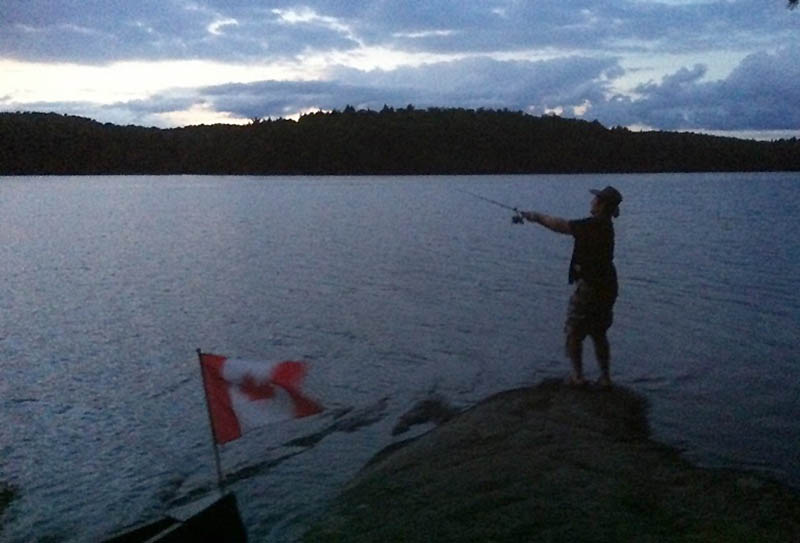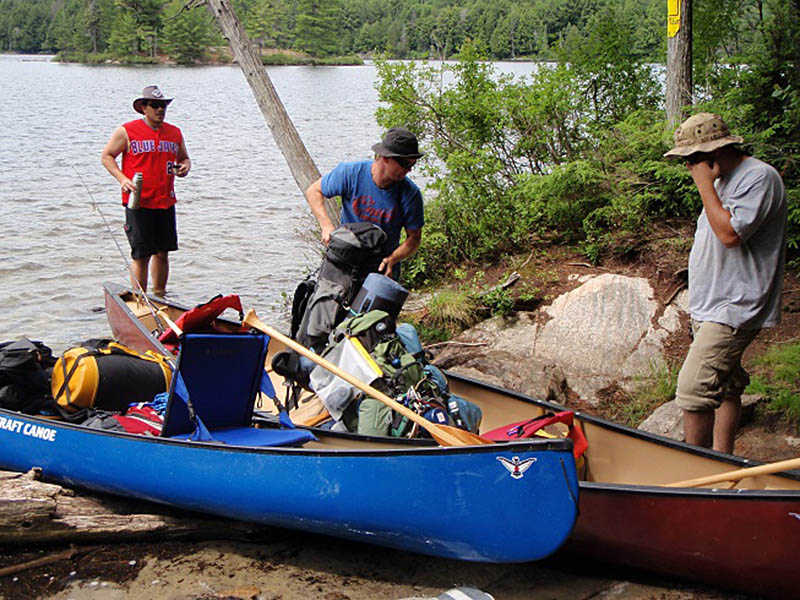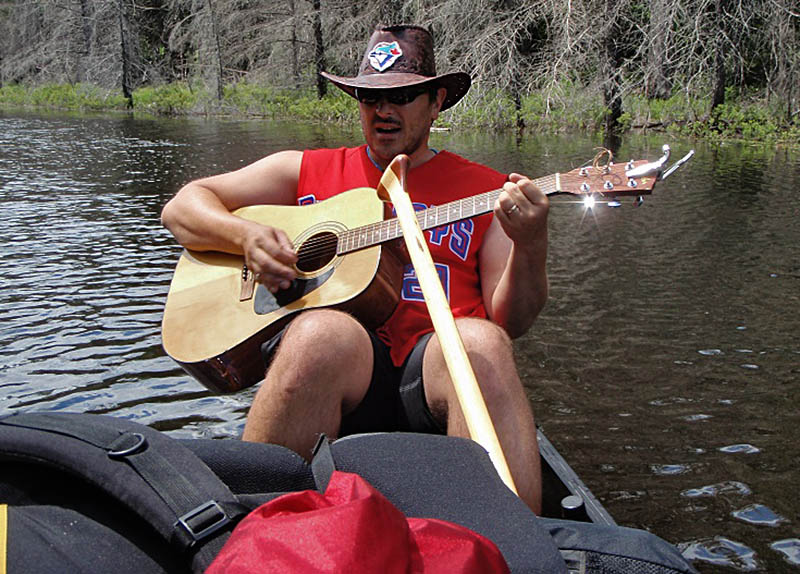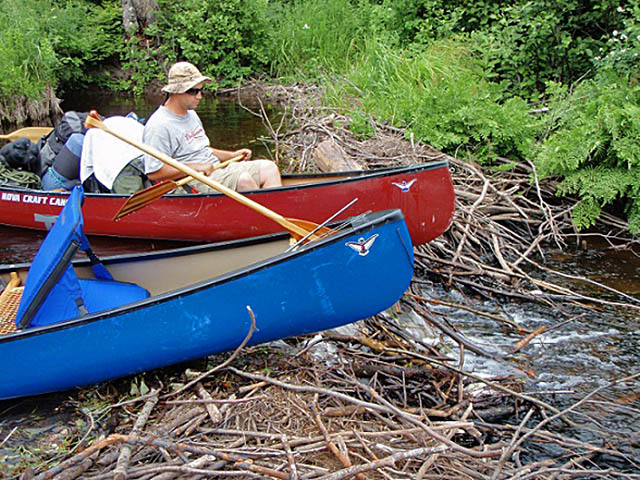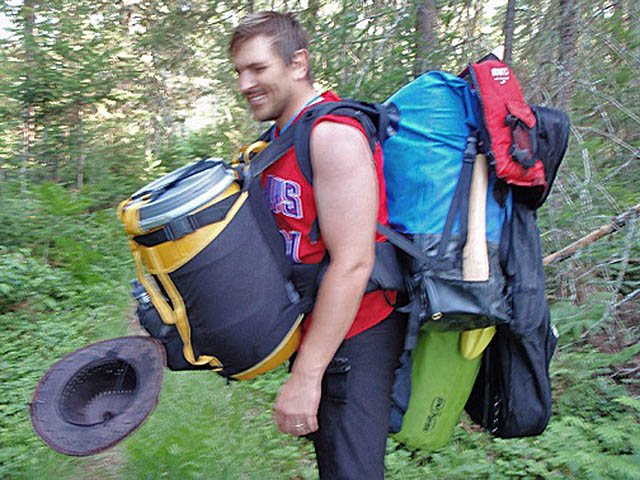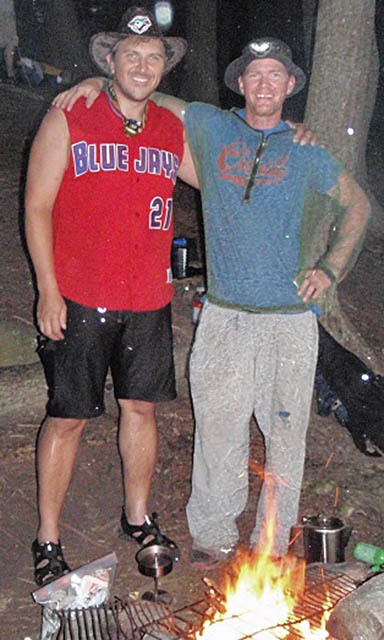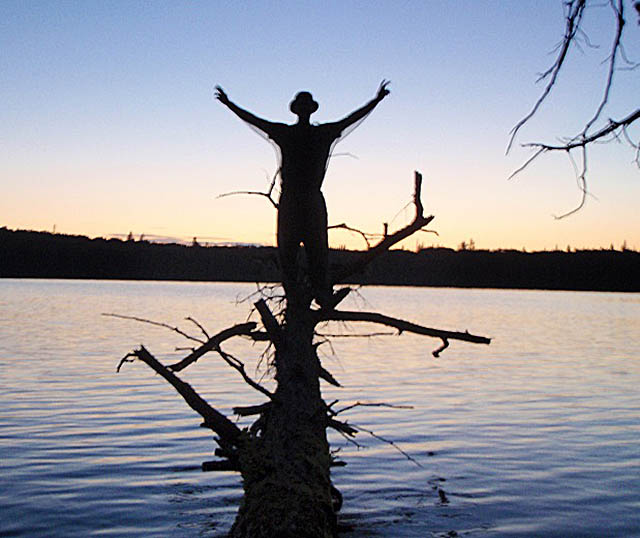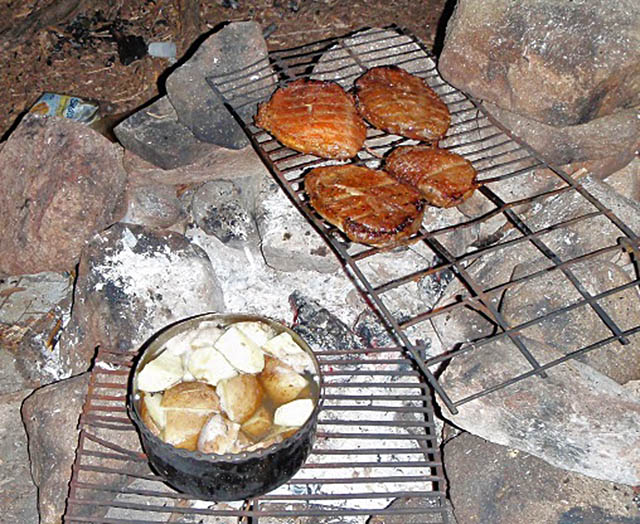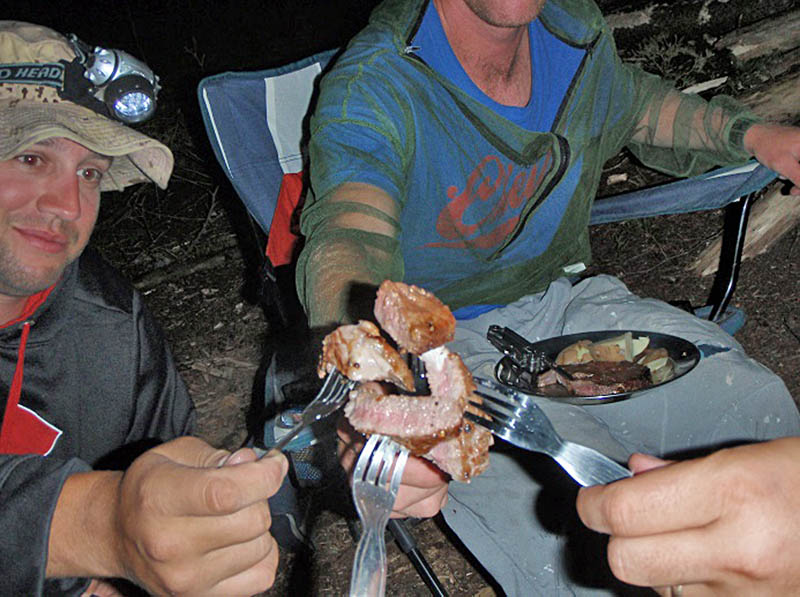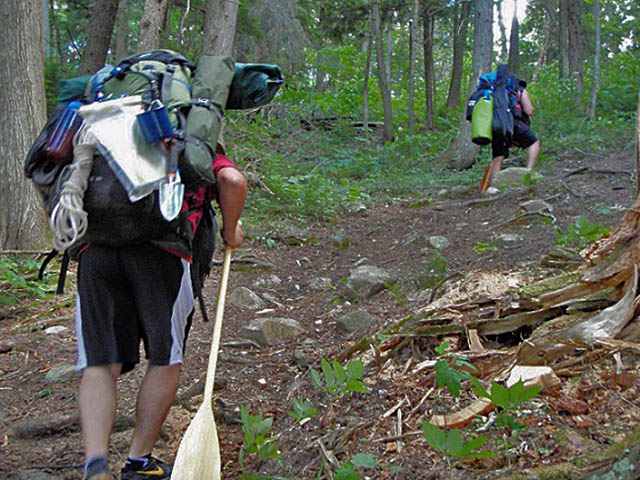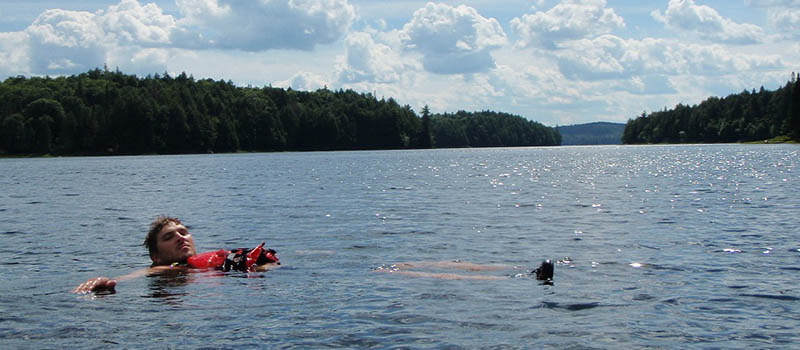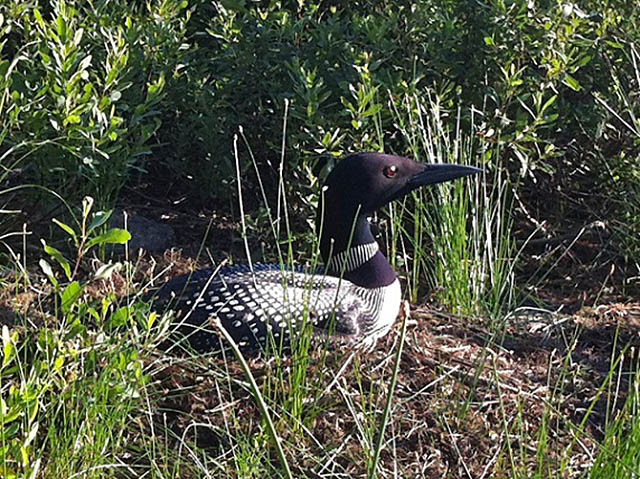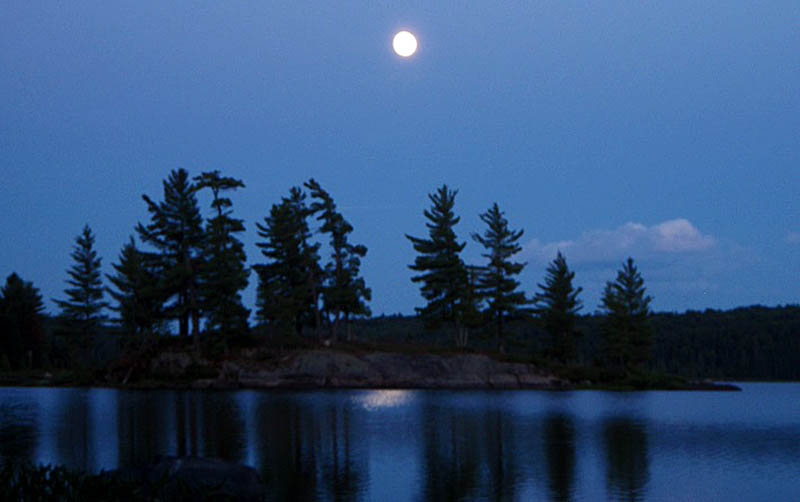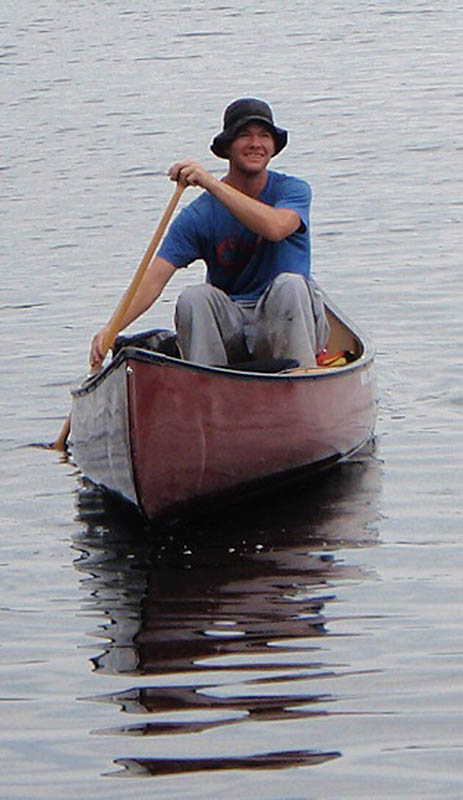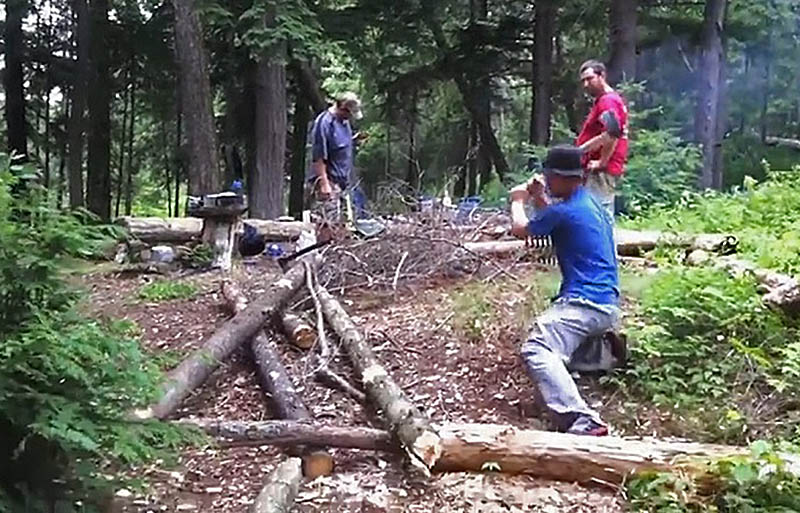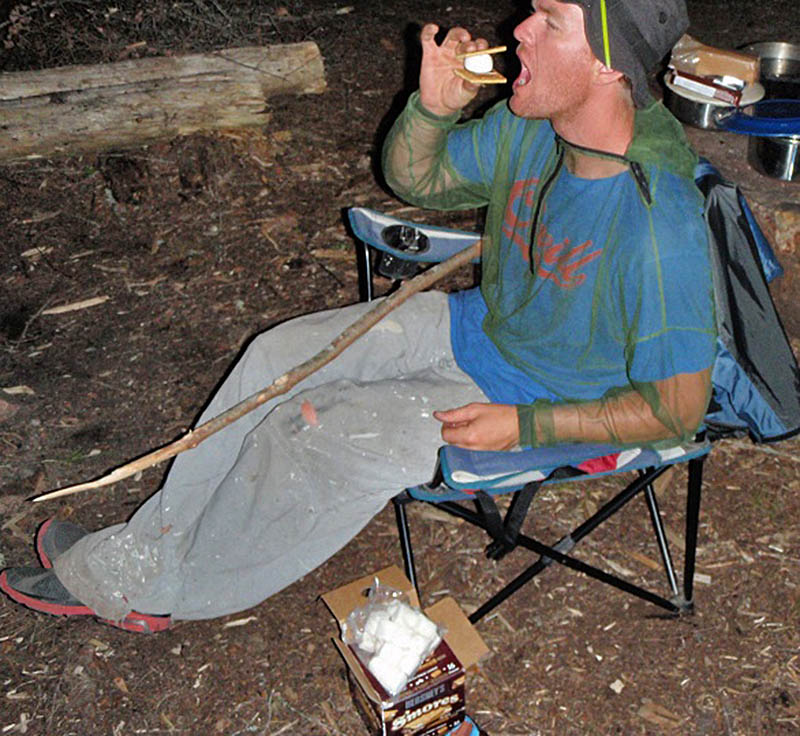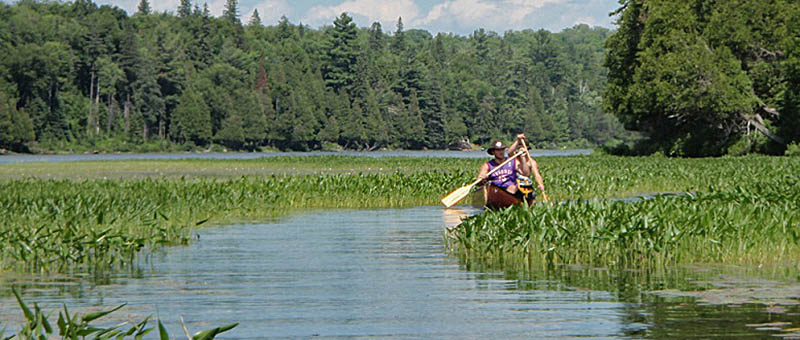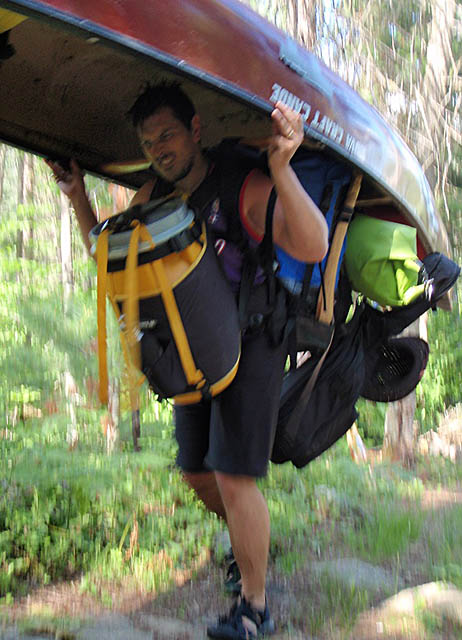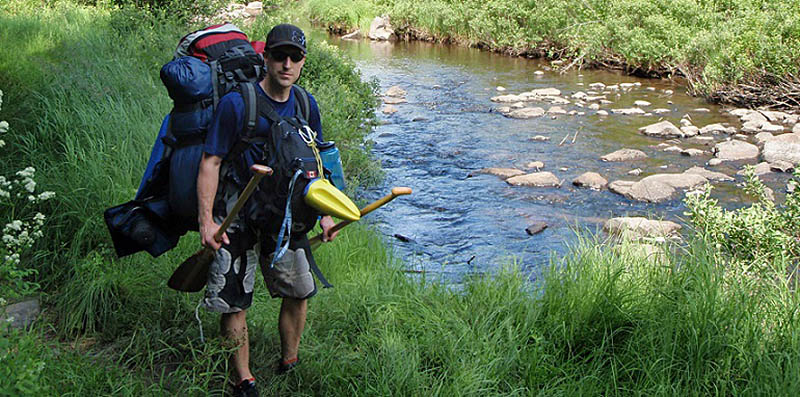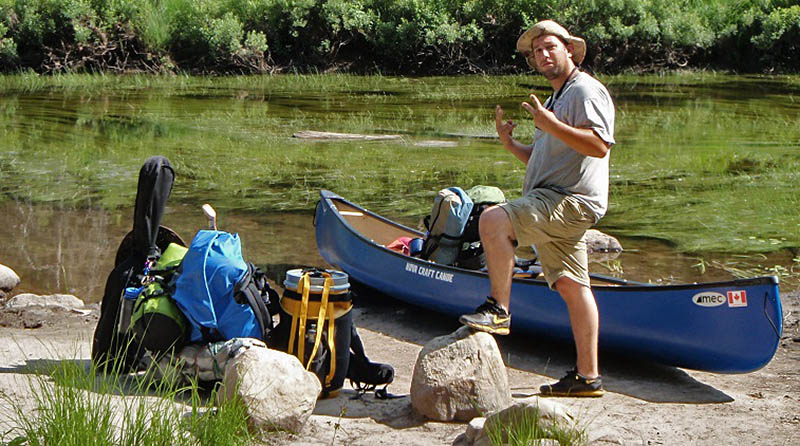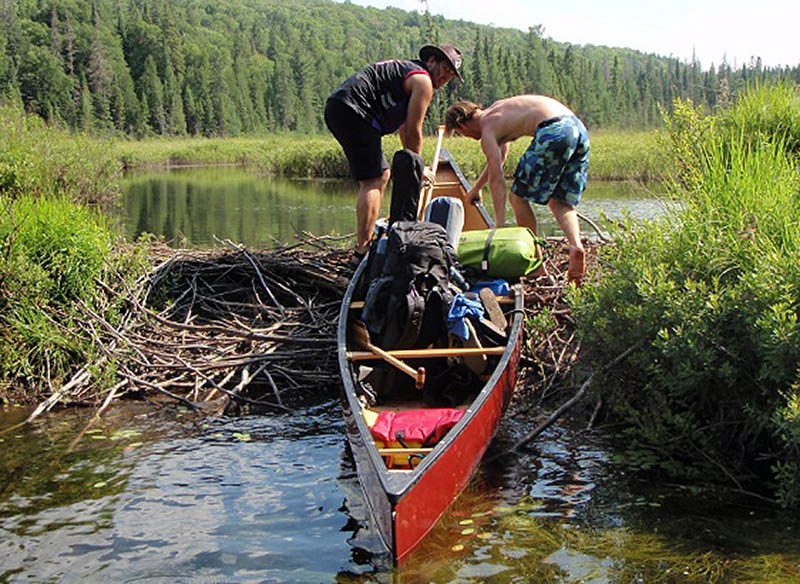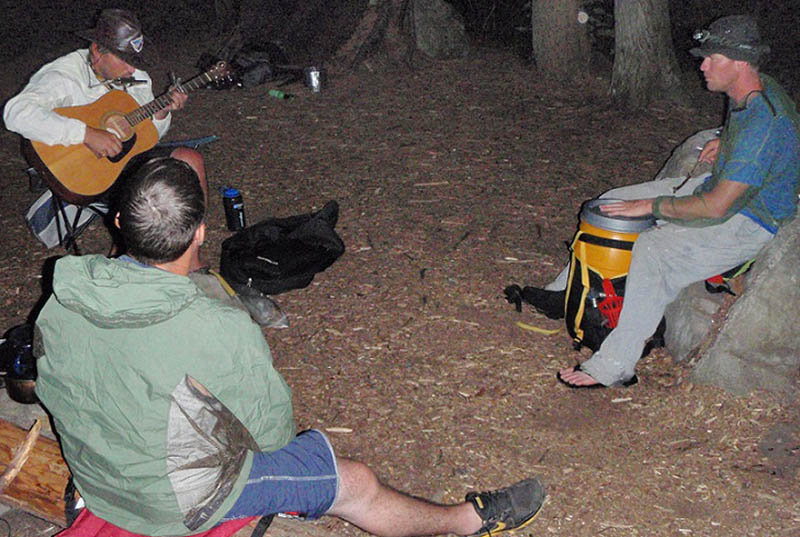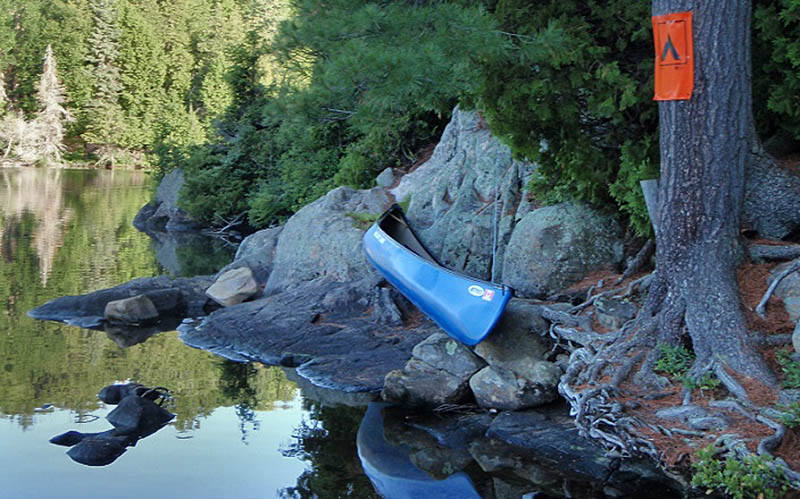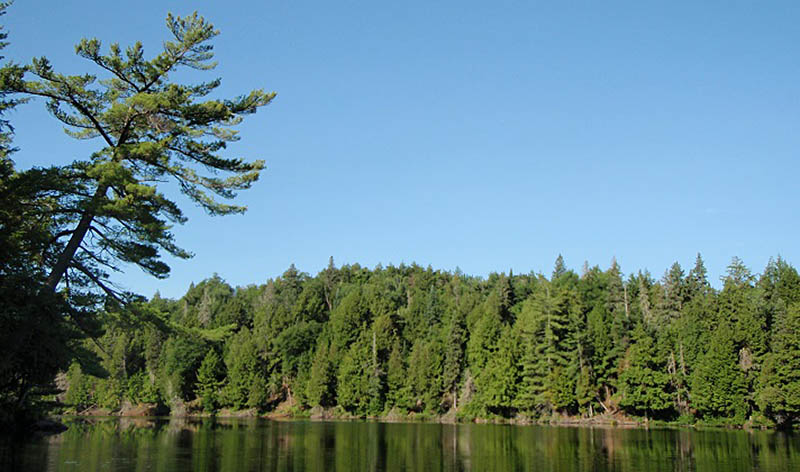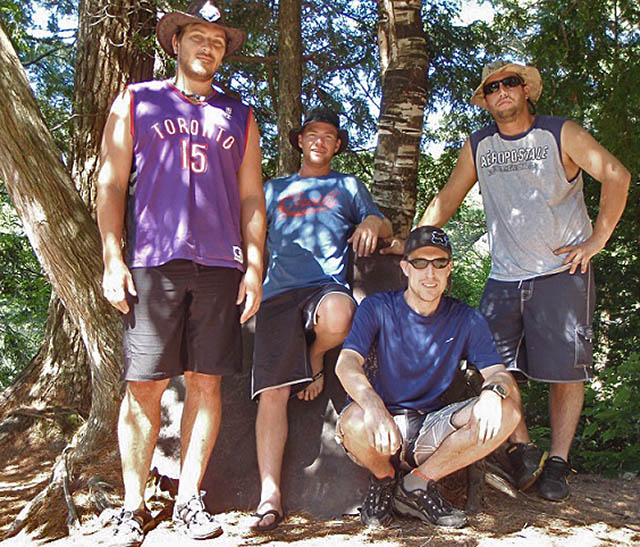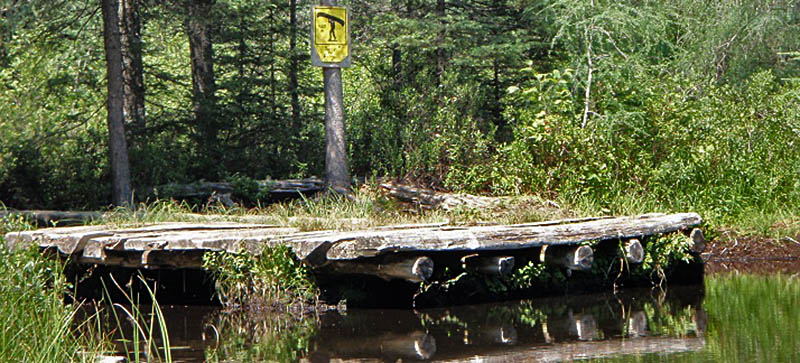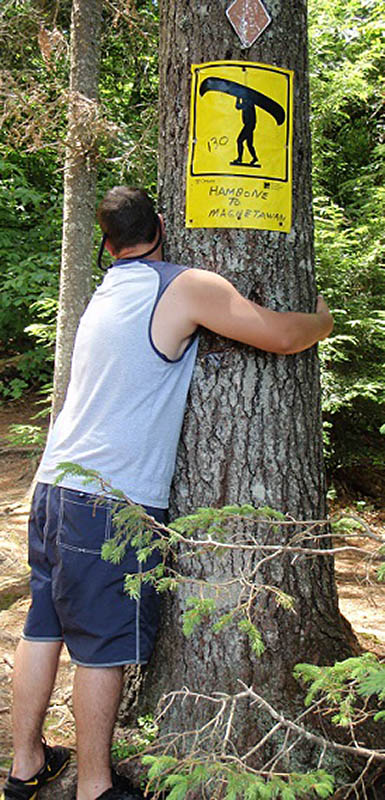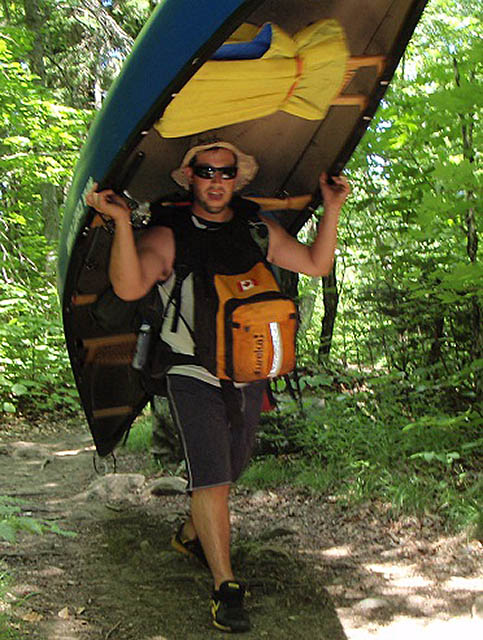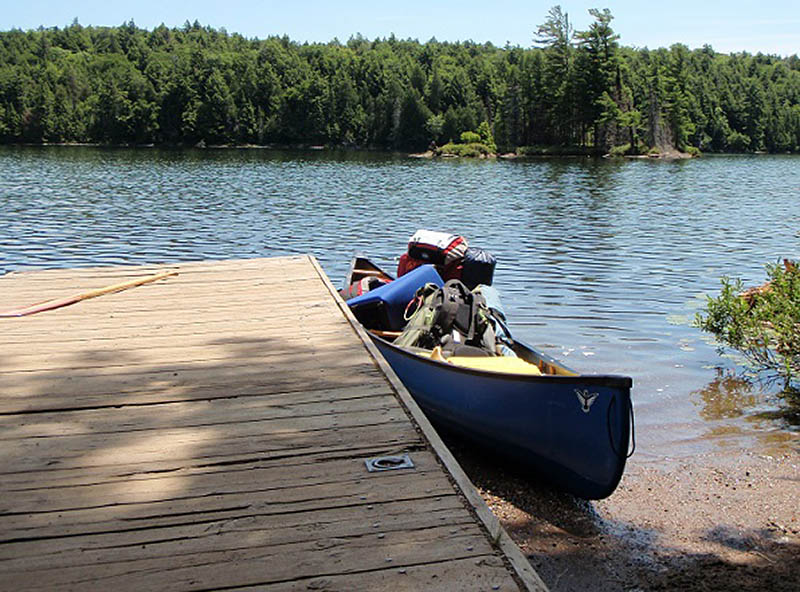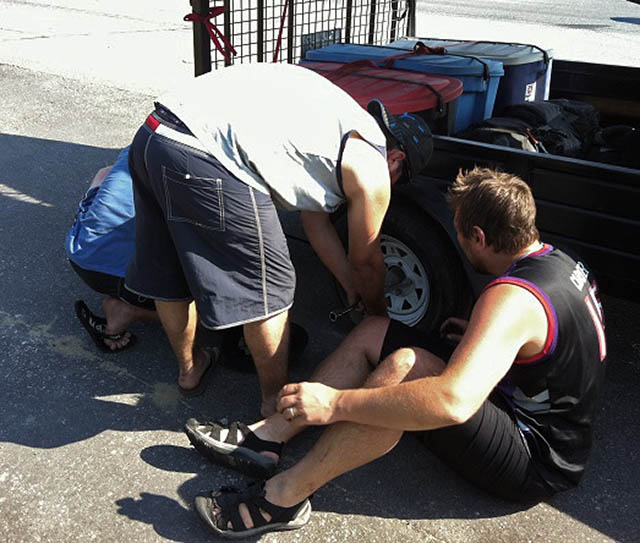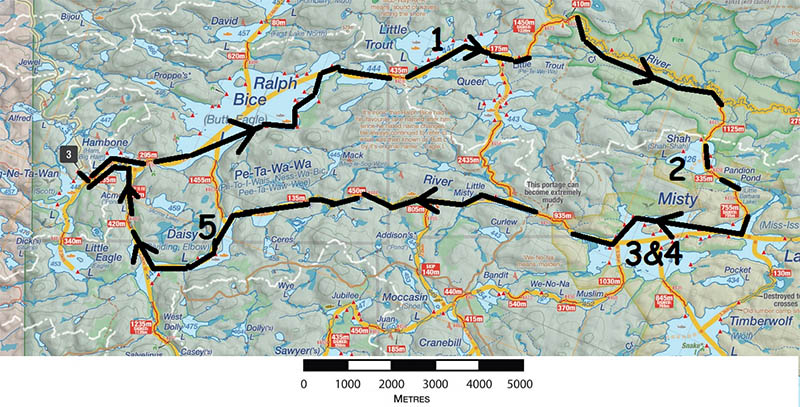DAY 1 The 2012 Algonquin trip ushered two new guys, Kris and Brock, into our group and take Ryan and I to an area of the park we had never been before .. the west side. This year’s trip also had us using one vehicle towing a trailer loaded with canoes and large plastic totes full of camping gear. Not only did the totes prevent our gear from getting prematurely wet from any rain showers we may encounters on our drive to Algonquin, it also protected it from the heavy dust encountered on the long drive down the gravel access road from the highway to the access point After we loaded up the canoes at the put-in, we quickly made our way through Magnetawan and Hambone Lakes to Ralph Bice Lake. Ryan and I had learned from past experiences not to wander too far from shore while travelling on large lakes. So, we all travelled within about 100 feet of the southern shore of Ralph Bice Lake. With the wind coming out of the northwest that day, we were sheltered from the wind for the first quarter of the length up Ralph Bice Lake, but once we made it into the main section of this lake, the wind and waves picked up. Ryan and Brock were doing alright with minimal water getting into Ryan’s deep hull Nova Craft Prospector canoe. However, Kris and I were struggling to keep the crashing waves out of my fairly shallow Nova Craft Pal canoe. The fairly shallow hull of the Pal makes it a great canoe to steer in the wind, as the canoe is not affected very much by the wind because of the low profile. However, when faced with a heavy load and large waves, this canoe can take on water in a hurry. While taking on water from the occasional wave, Kris realized that his water bailing was not keeping up with the amount of water we were taking on from the waves. The problem we had was that in order to empty the water from our canoe to be able to safely continue our journey up Ralph Bice Lake, we would have to land the canoe on shore. At this point on the lake, the southern shore had no place to land a canoe because of a rock wall and heavy vegetation. After some tense moments of paddling and bailing, Kris and I found a safe location in a bay, landed the canoe, emptied the water and continued on to the portage into Little Trout Lake, which was our destination lake for night-one. We found a relatively good site on the south shore, across from the island, and went about setting up our tents and preparing dinner while Kris played his guitar. We had planned on eating steak with potatoes for our first night, but the steaks were wrapped so well in newspaper and aluminum foil, that they were still frozen solid, so we all went about cooking our own personal meals for our first night and saved the steaks for night two. After dinner, Kris and Ryan went for a swim while Brock and I fished from shore. Once the sun went down, we all settled around the fire for more live guitar music and some mixed drinks. For mixed drinks we follow all park rules and Leave No Trace ethics and bring only plastic bottles of liquor. To us this is kind of a no brainer anyways, because plastic weighs less than glass and plastic containers will not break and spill booze all over our camping gear. DAY 2 Day two would start out with fishing from shore while we cooked and ate breakfast. Once on the water, we made our way across the lake to the portage to Queer Lake. Once on Queer lake, we paddled into a small bay that entered Little Trout Creek. When we got to the bay, we thought it would be a great area to do some fishing and relax before we tackled the 1450 meter portage. We dipped our fishing lines in the water and were treated to a live guitar performance by Kris. Needless to say, this is one of my top five best experiences in the park ever. When Kris was done playing his song, some people that had just finished a portage hike surprised us with an applause and they commented that we were a bunch of guy that looked as though we had just won the lottery. After our rest, we tackled the long portage to the Tim River. Once at the put in, we had a quick rest and started down the river. This section of the Tim River is a very skinny river that weaves its way through tall grass and shrubs with several beaver dams to lift over along the way. This section was very tough to estimate how long it would take to paddle simply by looking at a map, even a detailed one such as Jeff’s Algonquin Map, because so many factors are in play .. such as the number of beaver dams changing annually and the water level. In any case, the river was fairly low and we had to walk the canoes over several gravel sections. But all-in-all it was a fun paddle through a unique body of water that took us two hours of moderate paddling to complete. We then faced a 1,125 meter portage to our campsite at Shah Lake. Along this portage, we stumbled across several teenagers and a few adults who were looking pretty wore out after a long day on the water. The adults mentioned that they were attempting to make it to Misty Lake so they could camp as per their camping permit and we mentioned that Shah Lake was our destination lake for our campsite than night. By the time I was just finishing-up portaging my gear to the end of the portage at Shah Lake, while Ryan and Brock were still on the portage, I overheard several of the teenagers and adults chatting amongst themselves about staying on Shah Lake instead of Misty Lake. I then witnessed two kids jump in an empty canoe and tell the adults that they were headed out in front of their group to find the best campsite on the lake. Because our group of four guys did not have our canoes even close to loaded up yet, we could only watch them paddle like crazy to find the best site on the lake, even though this wasn’t the lake they were suppose to stay at. This was a pretty ignorant move by not only the kids, but the adults that should have known better. Because we didn’t want to have conflict in the middle of the bush, we decide to take the high road and camp at the other campsite on Shah Lake, which just so happened to be a small campsite with no flat spots for tents. After we set up camp, we got a fire going, unwrapped our still cold but thawed steaks, boiled potatoes and grilled the steaks over a hot bed of coals. For some reason, any steak or fresh meat I’ve ever cooked and ate on backcountry camping trips always tastes better and this meal would prove no different. Just after sunset Kris played his guitar and sang a song he wrote himself called Proud to Call Myself Canadian, as we celebrated Canada Day the best way we could think of, around the campfire in Algonquin Park. This night ended up being a cold night, so Kris and Ryan decided to stay up all night around the campfire to keep warm, while Brock and I tried to get some shuteye. DAY 3 I woke up before sunrise because I was so cold, and because I had slid to the bottom of my tent due to the extreme angle at which my tent was sitting. Upon getting out of my tent to start a fire to warm up, I found that Ryan and Kris were still awake and had gone for a sunrise swim. Eventually after sunrise, Kris and Ryan finally went to sleep for a few hours and I headed out on the lake to do some fishing. By about noon hour all of us were awake. And by 1pm, we were packed up and ready to take on the first of two portages of the day. The first portage to Pandion Pond was an easy stroll. After the very short paddle across Pandion Pond, we came to the start of the second and last portage of the day. The portage was a 755 meter portage with several short uphill sections. But it was the first 100 meter section, that we would eventually name “the wall”, that was the most memorable. After we put the portages behind us, we moved out onto Misty Lake where we would spend two nights. For that reason, we decided to take scout out a few campsites and pick out the best site we could find. We ended up finding a large site, which allowed us to play some Frisbee and football. The site came “fully furnished” with several large logs to sit on, and granite end-tables for our camp stoves, multiple flat spots for our tents, and a large rock to fish from. It even had an ample supply of dry firewood, due to all the half fallen dead trees nearby. The site was located in a bay across from a lightly treed island which we swam out to and relaxed on in the warm afternoon sun. While at the island, Ryan spotted a loon sitting on her nest, so without disturbing her, Ryan and I both had a chance to take some pictures and video of her. We swam back to the campsite, dried off, got a fire going, had an early dinner and went to bed fairly early that night. DAY 4 In the morning we found the sky had clouded over and the temperature had dropped slightly. And although the wind was just a slight breeze, it felt like rain was on the way. After breakfast, we all did some fishing again and just relaxed soaking in the quietness that is Algonquin. Being that the sky was overcast with just a light breeze, I paddled out in the bay, put my anchor down and had an afternoon nap while lying in the bottom of the canoe. Later in the afternoon we spent a few hours collecting and processing lots of firewood in anticipation of the rain that never did fall that evening. After dinner, we all settled in for a campfire and finally dug into the S’Mores that Ryan had paddled through seven lakes, one river and carried across eight portages. We were all grateful for his efforts in bringing a rare treat to day-four of a backcountry trip. DAY 5 Day five started out with most of us having a large breakfast of scrambled eggs, Ready Crisp bacon and coffee. After packing up and getting out on the water, we traversed Misty Lake to our first portage of the day where we came across our first moose of the trip. Once we got too close to her, she headed off up a rocky creek where we lost sight of her. Once at the 935 meter portage to Little Misty Lake, I headed down the portage ahead of the other guys while Ryan and Kris hung around and managed to spot several more moose at the creek near the start of our portage. As I was walking I spotted a familiar uniquely designed red and white maple leaf Nova Craft canoe with none other than canoe camping expert and author Kevin Callan portaging it in the opposite direction as I was headed. After chatting with him for a few minutes, I found out he was doing a family canoe camping trip across the width of Algonquin. At the end of the portage we all had a chance to chat with him and his family, who at this time were just picking up the last of their gear from the starting point of their portage. His daughter was quite concerned she had not seen a moose yet and we tipped her off that there was in fact a few moose at the end of the portage and I’m sure she made short work of the portage ahead. When I read one of Kevin’s magazine articles later that summer, I found out that she did in fact see several moose that trip! We worked our way up the fairly deep, but slow and narrow Petawawa River, across three more portages and climbed several beaver dams. For paddlers, beaver dams are a necessary evil. On one hand they slow your progress down by forcing you to get out and lift a full canoe over the structure. On the other hand it raises the water level so that rivers and creeks stay deep, which prevents a likely slower advance up or down a river or creek. Being that it was a hot and sunny day, we didn’t mind having to get out of the canoes and get a little wet anyways. Once we arrived at Daisy Lake, we did some swimming to cool off at a small waterfall and worked our way down the lake and found a beautiful campsite on a large island. On the campsite we found a four foot diameter blade left over from the logging days which we later used for one of our group photos. We did some fishing at sunset, got back on land and started a campfire. After settling around the fire, Kris pulled out his guitar and harmonica, sang songs and we all joined in with makeshift instruments ranging from sticks cracked together to pounding our hands on the lid of the nearly empty food barrel. Later on Ryan and Kris dawned lifejackets and went for an evening swim. After a late night around the campfire, we all turned in for the night. DAY 6 I was the first to wake up on the last morning and found the lake had a thin fog layer floating on top of the water, just as the sun was rising. I hurried out to the lake in my canoe to do some fishing and photography. But unfortunately, most of the fog had lifted already. After breakfast, we loaded up the canoes and did some last minute fishing. Three short portages and two small lakes were all that confronted us as we made our way back to the Magnetawan Lake access point where we'd begun our journey just six days earlier. On the drive out of the park, Kris tested the endurance of his fuel gauge, as we drove at the level of “0 km to empty” for about half an hour before we finally found a gas station in the town of Kearney. At Kearney we grabbed pizza from a local business and relaxed in the wilderness for once last breath of fresh air before heading home. The trip would throw one last surprise at us as we were rolling into Huntsville when the trailer's right side tire blew out. Fortunately we had brought a spare tire with us, but unfortunately we did not have the correct sized wrench to remove the lug nuts. As luck would have it, we were within sight of the Huntsville Walmart, so while I stayed behind to guard the camping gear and canoes on the trailer, the guys unhooked the trailer and drove across the street to purchase a lug nut wrench. In the end we counted ourselves lucky that the tire didn’t blowout while we were deep in the bush or on the 400 or 401 highways. 2012 Trip Summary Every year we gather together and mull over different routes and this year’s trip was chosen in an area of the park that was new to all of us. It did not disappoint. Initially I was a little hesitant to visit this area of the park, because I had heard it resembled the deciduous forests of southern Ontario, and I was more interested in spending time in coniferous forests. This was of little issue once we arrived, as the area has a healthy mix of coniferous trees within the predominantly deciduous forest. We'd all been a little worried about this area of the park being overly busy with other canoeists, as it was much closer to urban centers compared to the north east of the park where we normally visit. But to our relief, we only encountered a few groups of people each day. Having the right group of people can make or break the overall experience of the trip and as it turned out everyone in our group meshed well together and made this trip very enjoyable. The addition of a guitar was a welcome treat as it provided a nice change in pace when we needed a little entertainment. Planning a rest day in the middle of the trip proved to be a great idea as it gave us time to settle in and relax halfway through the trip. I did enjoy the afternoon paddle we had on the Tim River, but the long portages before and after this part of our route did not make it something we wanted to duplicate anytime soon, which gets me to thinking about portage trips in general. Lengthy portages, or any portages, are something we all loathe at the time we are walking them, but it comes with so many benefits that are hard to realize until after you complete a canoe trip. For starters, it helps you create distance between you and the “crowds” of canoe campers that do not want to do portages, which gives you a true wilderness experience without the noise of other people. The overall experience of a portage canoe trip makes it memorable for negative or positive reasons, because of how much work it is. In our modern life, things come so easy and it is makes it easy to miss the good things in life, but when you struggle to get to a destination, you slow down and enjoy the journey and once you arrive, you also appreciate every aspect of the destination. There is a lot of personal and group satisfaction that a tough portage trip produces that is hard to explain to people that have never done a canoe camping trip and it is that reason I enjoy planning a trip that pushes the groups limits a little, but still keeps it manageable and enjoyable for everyone. We always want to travel and see as much as possible in the short amount of time we are able to spend in the park and I feel that this year’s trip provided a nice moderate level of travel per day. We spent some four to six hours travelling in between campsites each day, but we managed to fish, explore and even relax along the way which made it an enjoyable trip, for me at least, day to day. A full length movie of our trip has been posted on YouTube and can be found at this address: https://www.youtube.com/watch?v=PQJuIrhcda4
